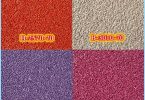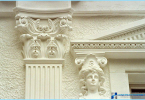The contents
- The types of Venetian plaster
- The beginning of the work
- Training
- The process of applying Venetian plaster with your hands
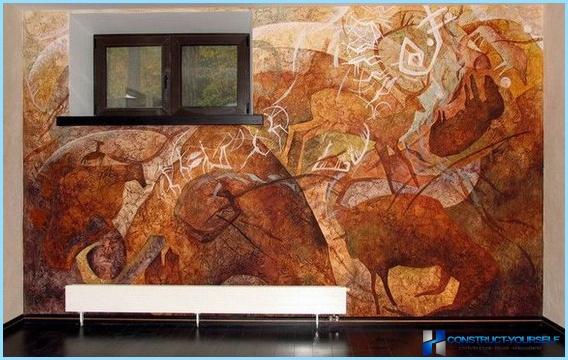
Venetian plaster looks beautiful and expensive, both at home and in the office. A huge number of various colors allows you to choose the coverage that best fit to the overall design of the room.
The coating process is not particularly complicated. If necessary, Venetian plaster can be done by hand. Just follow the simple rules and the timing of exposure of each layer.
The history of ^ the
For the first time this technology began to use in Ancient Rome. Since then, it took many years before the lost knowledge was revived in Venice and caused a real sensation in the field of architecture and interior decoration of the premises. At the time Venetian plaster bore the proud name of stucco veneziano.
The use of Venetian plaster in Rome related to the banal desire of builders to save money. At that time senators from the inside of the house was overlaid with marble. But its production and delivery stood considerable money. It is not surprising that shrewd builders very carefully treated to the waste production and sought to minimize the excess.
The result was astounding. Crumbs, dust, and damaged blocks were used in construction along with real marble. In appearance all these elements after treatment is not very different from the original material, but their cost was significantly lower.
Again this method of internal decorating received its birth in Venice in the form of plaster. The fact is that the great artists of antiquity was painting the walls in churches and cathedrals. As canvases, they used a plaster wall. Even now, everyone can enjoy the creations of the masters who more than a century.
The composition of the material from century to century did not undergo major changes. Changing the ratio between components, adding new components, but the basis was always the same. In the XX century came the synthetic elements and a lot of techniques to follow this style of decorating.
The composition of the material ↑
The basis of a real Venetian plaster lies a granite, marble or quartz dust. Moreover, the smaller the granules, the higher the quality and the material cost.
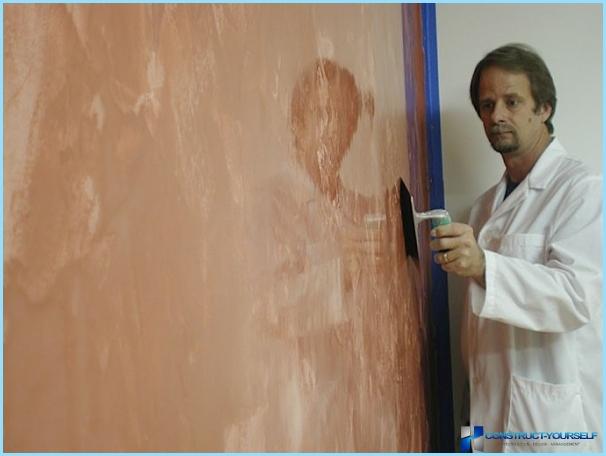
In ancient times, a binder between the particles of marble served as ordinary lime. Naturally, the composition was also water and the dyes, which helped to give the Venetian plaster desired shade. For this often used juices of various plants.
All components are mixed together until the substance is converted to creamy state. It is not surprising that now many people make a mixture. With modern materials and technologies, the production process could be run at home.
The reasons for the popularity of Venetian plaster ↑
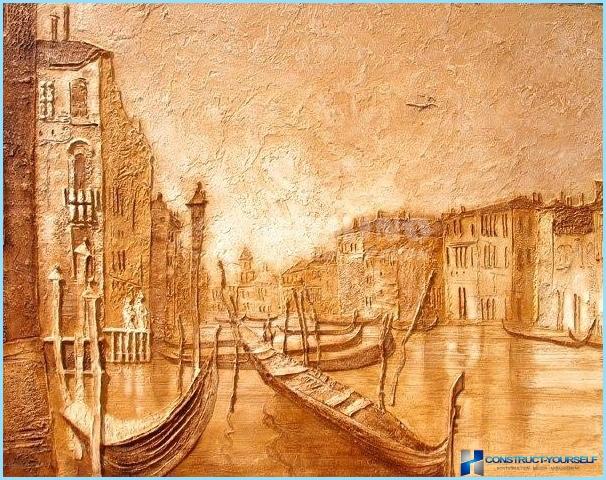
First, you can give the surface of any desired color and shade. Second, the appearance of Venetian plaster has always been distinguished by sophistication and elegance. Thirdly, the material has remarkable durability. The average lifespan is 10 years. It does not lose any Shine or protective qualities. Other benefits of the material referred:
- Environmentally friendly. The basis of the material, despite new technologies that make natural components.
- The possibility to create unique effects. The inner section of the Venetian plaster creates an unusual pattern.
- The durability and reliability. The structure of Venetian plaster is that even after many years it will not have cracks and chips.
- Additional treatment with wax allows you to do Venetian plaster impervious to water. Further offset by a negative impact from temperature changes.
- Venetian plaster allows you to hide defects of the wall.
An important advantage of this technology is that Venetian plaster can be easily restored and renovated. This allows with minimal costs to restore the damaged areas.
Unfortunately, despite its outstanding merits, Venetian plaster, has some drawbacks. For example, the cost of the decorative coating is very high. You also need to spend time on surface preparation for applying.
The properties of Venetian plaster ↑
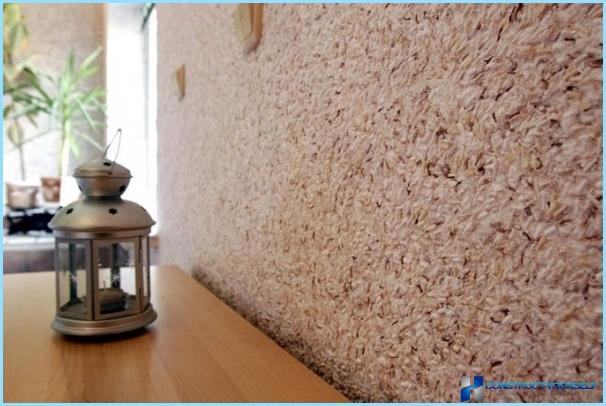
This natural material is absolutely not toxic. Besides, Venetian plaster can mimic not only marble, but also leather, wood and other textures. Also, the properties of the material referred:
- The Venetian mix of different varieties. The main difference is the size of the particles of marble dust.
- The substance has high strength, plasticity, and stickiness.
- Venetian plaster can be divided into three types: smooth, embossed, and artistic painting.
- Embossed Venetian plaster adds the effects of aging. In this mixture contain granules of marble grows to size 2 mm.
- Over time Venetian plaster is only getting stronger. Quality of the mixture can serve without restoration work about 20 years.
- Venetian plaster has the ability to absorb carbon from the environment. Due to the carbonation. Is formed on the surface of carbon film that creates an additional protective coating.
- Venetian plaster endures changes in temperature, rated range of -50 to +80 degrees Celsius.
- Venetian plaster is not water tight and protects the walls from fungus.
Venetian plaster applied to the wall manually. No wonder it’s not cheap. The coating does not need special care. It can be cleaned with a wet cloth, removing dust and dirt.
The application of Venetian plaster ↑
The types of Venetian plaster ↑
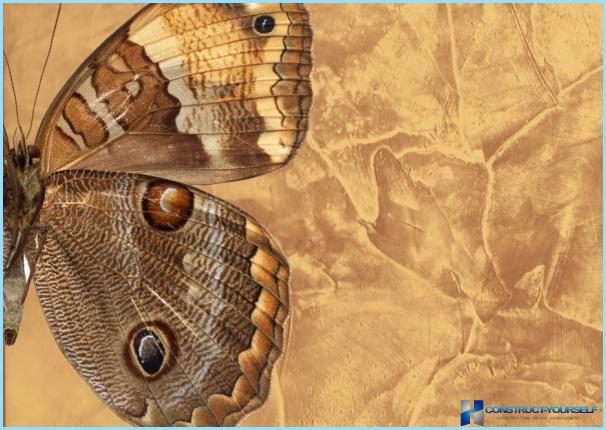
Before applying the substance you need to choose a kind of Venetian plaster. In the modern world of construction there are two types of this material: an acrylic-based and lime. The main ingredient is marble dust.
Of course, modern companies use a variety of substitutes to achieve the cost reduction, but in an authentic Venetian plaster have to be marble.
The inclusion of the acrylic allows you to achieve significant savings. The flow rate of the mixture becomes much less. While the appearance of Venetian plaster remains unchanged. Besides polymeric backing prevents the appearance of microcracks.
The beginning of work ↑
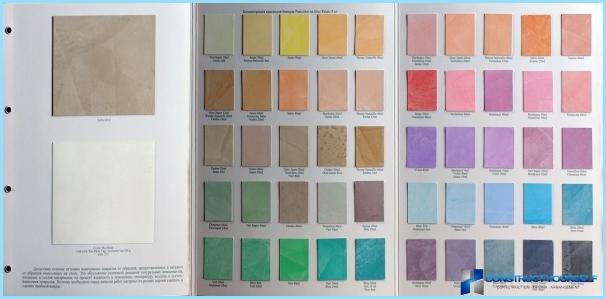
A special role when applying Venetian plaster is the quality of the mixture and its texture. Therefore, the construction process begins in the store when you pick up the necessary sample mixture.
In order to achieve full similarity with the natural stone it is best to focus on darker shades. Ideal grey, brown, beige and milky colors.
Modern technology of tinting allow you to create any color that will fit perfectly into the overall design of the room. Special attention should be paid to the additional effects. For example, if you want to get the texture in the form of streaks, like the real marble is a need to discuss in advance with the seller.
The mixture is applied in three layers. But to create a volume, you will need at least seven. Glossing allows to give the surface a Shine. To reinforce this effect, the coating is further treated with wax.
Basically, if you have no desire to create any special effects, Venetian plaster can cope with their hands. It’s time consuming, but simple process.
Training ↑
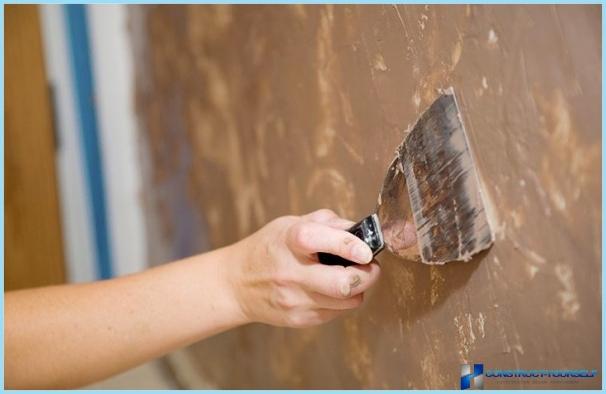
The most important role in the success of all the works played by the preparation. Need to take care about all the flaws and irregularities of the wall. For this is putty. It is very important that before starting, the surface was perfectly smooth.
To achieve a smooth surface initially reveals all imperfections, cracks and flaws. The bumps are sanded, chips and cracks are sealed. At the end is a solid filling.
When the putty dries, the surface otchitalsya skin. Through cleaning and apply the finish layer with the subsequent polishing. The period of drying of one layer 24 hours.
The process of applying Venetian plaster with your hands ↑
First of all, check you have the required tools you will need:
- the brush and roller,
- mittens for wax,
- spatula,
- metal trowel with rounded edges,
- masking tape etc.
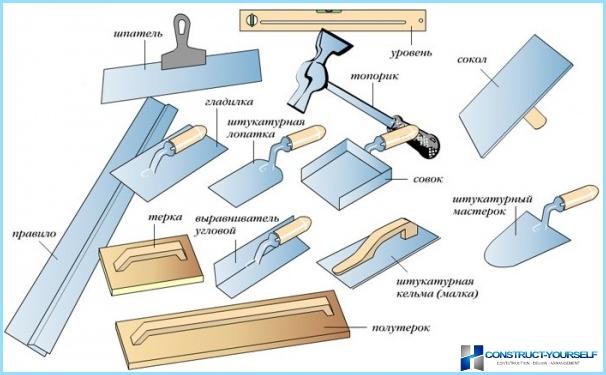
Before you start working with the mixture be sure to view instructional videos on Venetian plaster, links are provided below. The technique depends on the effect you want. Usually use short strokes or movements overlap.
The work begins with the overlap grip with a spatula a small amount of the mixture. It is superimposed on the edge of the trowel. The application is done with the upper right corner. Venetian plaster is distributed in small quantities uneven layer. It uses the method «from wet to dry».
The trowel is kept strictly at an angle of 15 degrees relative to the surface. The average layer thickness of about two millimeters. Drying takes 4 to 24 hours. In the end the surface is rubbed with a spatula. Also done a second layer.
The third layer is translucent. While Venetian plaster describeda at an angle of 80-90 degrees. At the end is glossing. The operation is done by trowel.
The results ↑
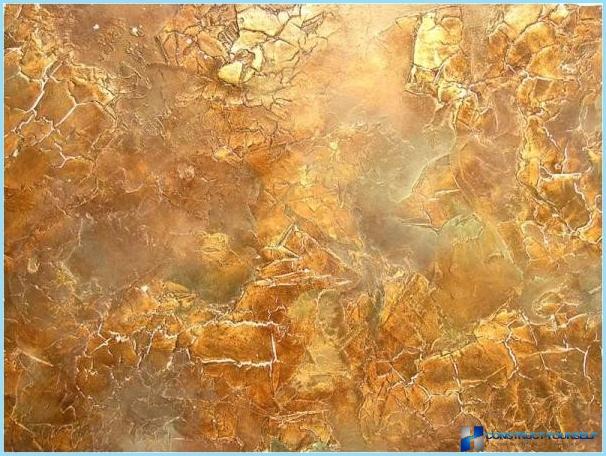
The above describes one possible method of applying Venetian plaster. In fact there are lots of them. The most popular included in the links of videos with master classes.


